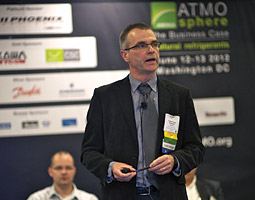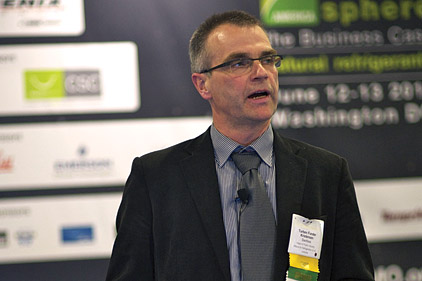
|
|
Torben Funder-Kristensen, Danfoss vice president, public industry affairs, speaks on the topic “Global Technology Trends and Development in CO2,” during the ATMOsphere America 2012 event in Washington, D.C. |
The significance of a recent two-day conference was not only the extensive presentations regarding natural refrigerants such as CO2, HCs, and ammonia, but where the meeting was held — Washington, D.C.
The event — officially called ATMOsphere America 2012 — was put on by the Belgium-based organization ATMOsphere, which has been hosting similar events in Europe for a number of years. The organization said it puts on workshops that “bring together decision-makers from industry and government to change the future of natural refrigerants.” For the D.C. event, some 200 individuals were involved in discussions designed to “build a business case for natural refrigerants in North America.”
The meeting came fresh on the announcement of U.S. Environmental Protection Agency (EPA) Significant New Alternative Program approval for three HC refrigerants in some applications, and plans to bring online both ammonia and transcritical CO2 supermarkets in the United States.
“The unanimous tenor (of the conference) was that natural refrigerants are entering the market and have already taken up some market share, that costs have come down, and that natural refrigerant solutions are conomically and environmentally the best choice in specific applications,” the organization said in a statement.
A number of sources have supplied reports from the event which are summarized below.
Technology And Cost
According to a press release from ATMOsphere itself, Scott Martin of Hill Phoenix, a manufacturer of refrigerant equipment, talked about entirely transcritical CO2 systems. Martin was quoted as saying, “Advansor (recently bought by Hill Phoenix) has over 600 installations of this technology all over Europe and now have some here in America. The first Advansor system built in the USA was built in our factory in Georgia … with the first installation in Vancouver performing well, and we have many more planned.”
It was the contention of Serge Dubé of CSC Refrigeration, a Canadian refrigeration system manufacturer, that the cost of CO2 transcritical systems has decreased dramatically. “Today, I can tell you that a CO2 system is easy to service, with less problems, less electricity costs ... I think it is the machine of the future ... easy to repair ... it costs less to repair and energy is very good.”
Mark Tomooka of Mayekawa, which makes industrial refrigeration compressors, said, “We will continue to promote natural refrigerants because this is not only a smart engineering choice, it is a smart environmental choice as well, and it definitely makes business sense.”
The conference included preliminary results from an industry survey on North America’s natural refrigerant potential. “More than one-third of respondents not using natural refrigerants today responded that they are planning to use them in the future,” said Nina (Burhenne) Masson of Shecco, a pro-natural refrigerants marketing organization.
An end user panel with representatives from supermarkets and consumer brands presented their views.
Richard Heath from the supermarket chain Supervalu, said, “Everybody in the room can get 90 percent natural today.” When asked about corporate attitude toward natural refrigerants, he said Supervalu has metrics that are financially tied to bonuses associated with sustainability goals, and incentives for investment in sustainable technology.
But, according to the online publication R744.com, “Mr. Heath [said] a lot of money that could be spent on new technology is currently being spent on carbon accounting.” The reference was to U.S. regulatory costs cutting into potential investment money for equipment with natural refrigerants.
Simon Bérubé of the supermarket chain Sobey’s, which includes the Price Chopper stores, talked about hesitation and cost barrier to the first installation of a natural refrigerant system. At the same time, he pointed out that although the upfront cost of CO2 may be a concern to begin with, over time this cost comes down to the point that retrofitting with CO2 becomes more cost effective. Berube said, “The renovation of a 24/7 store with CO2 systems has become cheaper than the cost of a new store that I was buying one year ago, so there has been a huge improvement in the cost.”
Kathy Loftus of the Whole Foods store chain, said, “What we are hearing is that start-up costs with CO2 are minimal, or better than with other systems.” She did note that in some parts of the United States it is difficult to install natural refrigerant systems because of the lack of technicians who know how to service these systems.
The upfront cost was discussed with Heath recommending comparing a natural refrigerant installation to an HCFC-22 DX system. Tom Hutchison of EnReps, a company that helps businesses deal with compliance, engineering, and workforce development, said that the Fresh and Easy store chain compares the natural refrigerant option to the available alternative that could be used instead. Harrison Horning of Delhaize America that owns the Food Lion and Hannaford supermarket chain, said that whenever the issue of cost comes up, it is suggested that decision-makers “take the long view for the economic analyses.”
Projects
Despite cost issues, a number of projects are underway. A summary of those came from the online publication R744.com.
In detailing the Sobey’s projects, it noted, “The Canadian retailer Sobey’s has installed different natural refrigerant solutions across 38 of its stores, including several CO2 cascade systems and 28 transcritical CO2 systems.”
It noted that Delhaize Group has about 2,500 stores mainly in the United States and in Europe and the standard in Europe is currently to use a CO2 secondary or cascade system. Meanwhile, the “company has also completed several CO2 transcritical installations.” Delhaize America has around 1,500 stores, with three operating with low-temperature CO2 or as cascade. One CO2 transcritical project is planned for 2013 in Maine.
The report said, “The first natural refrigerant system that Fresh & Easy installed in the U.S. was a subcritical CO2 system, now around two years old. Also installed are self-contained propane cases.”
It was noted that “Whole Foods’ first CO2 store was completed in 2009, a low temperature CO2 secondary system. In 2010 the company installed two CO2 cascade systems in California and Massachusetts. The company is now working on the design of their first CO2 transcritical store.”
Supervalu has installed various types of systems ranging from glycol to ammonia, it was reported. The latest installation is an ammonia installation that has a Mayekawa ammonia primary system on top of a Hill Phoenix CO2 system for the medium temperature cascaded to a DX system on the low-temperature side.
The EPA was also part of the ATMOsphere America 2012 event. An end user panel was moderated by Keilly Witman from the EPA’s GreenChill Partnership.
“This is going to be an incredibly exciting year: First ammonia system, first CO2 transcritical system in the U.S.” she said.
Perspective
A statement from Danfoss noted its participation in the ATMOsphere America 2012 event and a presentation from the company’s Torben Funder-Kristensen, vice president, public industry affairs, on the topic “Global Technology Trends and Development in CO2.”
In his presentation, Funder-Kristensen provided a historical overview of CO2 global technology developments during the past decade and discussed how the North American market can overcome adoption barriers — specifically training and capital costs constraints.
CO2 has proven to be a competitive and environmentally benign refrigerant for supermarket/food retail and industrial refrigeration applications, he said. North American supermarkets are beginning to use CO2 refrigerant together with HFCs with increasing frequency, while industrial applications using CO2 and ammonia “are also well accepted and will begin to dominate the market.” He added, “Used together, CO2 and ammonia can help reduce system installation costs, as well as provide higher efficiencies resulting from the viscosity of CO2 and superior heat transfer properties.”
Funder-Kristensen further commented, “The use of CO2 has been shown to trigger innovation. CO2 and ammonia cascade systems have the potential to become the standard for low-temperature applications due to the lower investment costs and, more important, lower operating costs. Heat reclaim provides a major opportunity to be realized in the near future.”
Robert Wilkins, vice president, public affairs for Danfoss North America, also participated in the conference, moderating a session on refrigerant standards, regulations, and training that included presentations from the U.S. State Department, EPA, Department of Energy, Underwriters Laboratories, and RSES.
Wilkins commented, “The state of refrigerants has been a critical topic to many stakeholders within the HVACR industry in recent years, and the emergence of natural refrigerants is reshaping how manufacturers, contractors, and end users approach industrial and commercial refrigeration applications — especially as more companies are being driven by the demand for corporate environmental responsibility; energy savings; and the need for simple, resilient systems.”
Publication date: 10/22/2012



Report Abusive Comment